The

by Leonard Higgins
This web page is presented for those who have an interest in the spectrohelioscope
and perhaps the desire to build one of these interesting instruments.
George Ellery Hale (1868-1938) invented the spectrohelioscope in 1924 which
allowed detection of sudden outbursts of activity on the sun. The
following photographs are of such an instrument, built by Leonard Higgins
with the support, and guidance of Fredrick Veio, author of the book,
"The Spectrohelioscope." This particular instrument has
been on display at the RTMC (Riverside Telescope Maker's Conference)
at Big Bear Lake, Camp Oaks in California, U.S.A., for the last two conferences,
1998 and 1999. It received a Merit award at the RTMC , 1998.
"The instrument is a pleasure to use, and provides many different
aspects and challenges in regard to observing the closest star, our sun."
The spectrohelioscope with some modifications
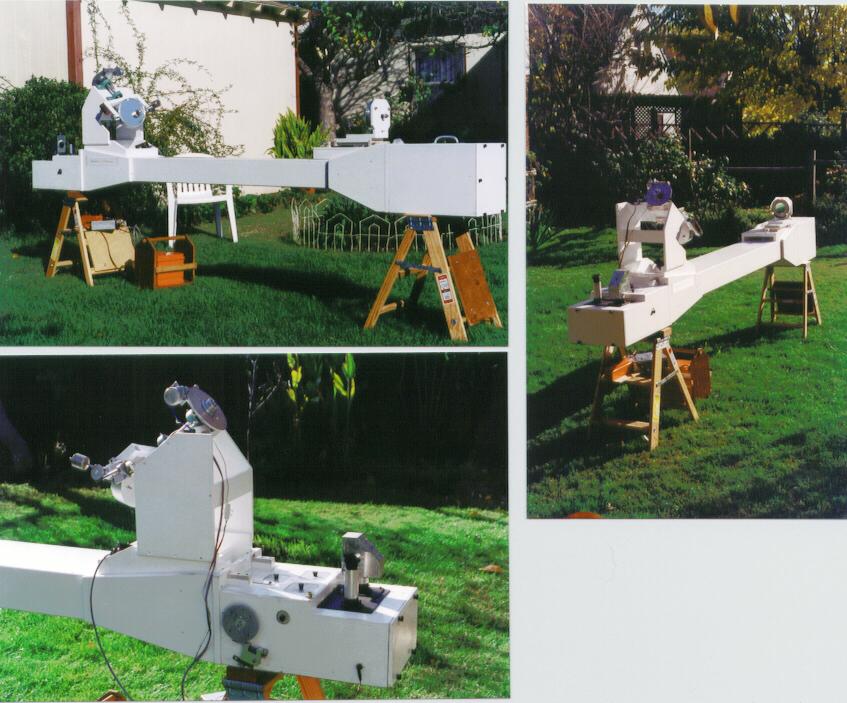
During the last part of summer 1998 a new heliostat was designed
using a 6" flat of 1/4 wave. It has a right ascension drive and a
declination drive to move the image of the sun using a control paddle.
The original 3 1/4 inch refractor lens was replaced with a 9 foot focal length mirror that
produces a one inch diameter image of the sun. (A barlow of 2" dia. 500mm
F/L is now used in conjunction with the mirror producing a F/L of about
20 feet and an image of approximately 2 1/8 " dia.) A
worm gear system was also constructed to tilt the diffraction grating from
the first order to the third. At this time only the first and second order are
used in the spectroscope mode to any advantage.
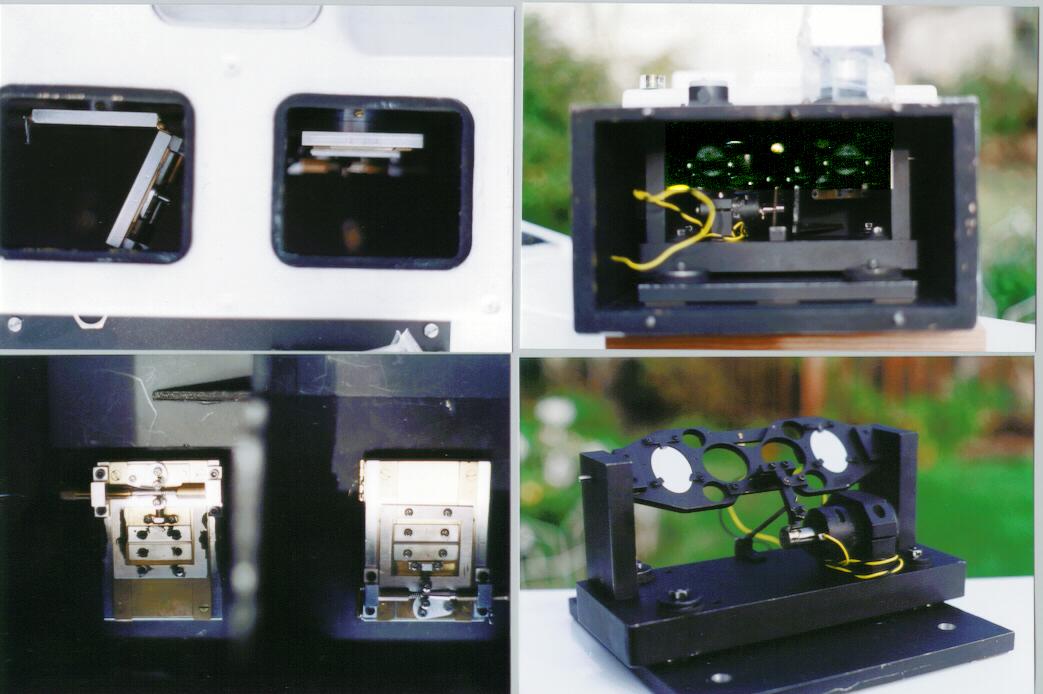 These photographs (left side) show the entrance and exit slit arrangement
and the (right side) nodding mirror mechanism. The slits are adjustable
and were designed similar to the method explained in ATM, book II, page
503 (publication by Scientific American - 1970). The slits are not
calibrated, but present little trouble in acquiring the ideal opening for
either spectroscopic work or use in the spectrohelioscope mode (viewing
the disk of the sun). If you notice in the upper left photograph,
the exit slit is opened as a door. It is installed on hinges to allow
easy conversion from one viewing mode to the other. The entrance
slit remains stationary.
These photographs (left side) show the entrance and exit slit arrangement
and the (right side) nodding mirror mechanism. The slits are adjustable
and were designed similar to the method explained in ATM, book II, page
503 (publication by Scientific American - 1970). The slits are not
calibrated, but present little trouble in acquiring the ideal opening for
either spectroscopic work or use in the spectrohelioscope mode (viewing
the disk of the sun). If you notice in the upper left photograph,
the exit slit is opened as a door. It is installed on hinges to allow
easy conversion from one viewing mode to the other. The entrance
slit remains stationary.
The nodding mirror synthesizer was adapted to the spectrohelioscope about 20
years ago by Jeffrey Young as explained in Fred Veio's book.
It needs to be made so it will induce little or no vibration in the optical
light path of the spectroscope section which could create movement
of the air currents, degrading the quality of the image. A heavy
steel plate was used as the mounting for the small electric motor (with
eccentric wheel - cam) and the vertical supports for the aluminum nodding
plate that holds two diagonal first surface mirrors. The steel plate
is then spring mounted on a large aluminum base which is then attached
(cushioned with camper shell foam sealer) to the wooden box of the spectrohelioscope.
Readily available material was used to isolate as much vibration as possible.
The follower that rides on the eccentric wheel was made from a discarded
set of automobile ignition points. The fiber section was used and
a small amount of cam lubricant is applied on occasions. As a result this
system works well.
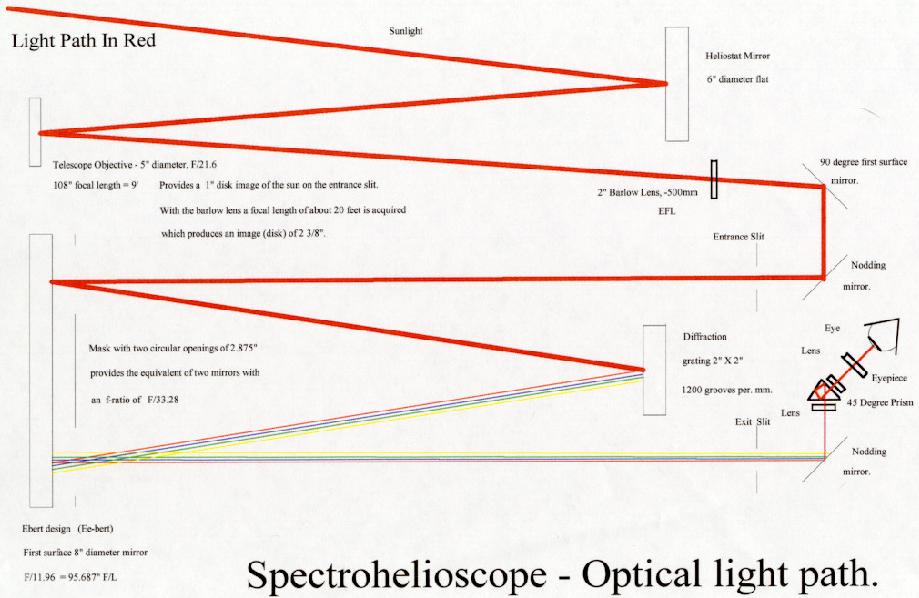
This diagram shows the current optical system in use at this time. The
distance between the nodder mirrors and the slits is 6 inches. To
bring the image to a comfortable viewing angle an eyepiece system
(trial and error) was acquired. A 45 degree erecting prism
with two small achromatic lens of 3.5 inches f/l, placed on either side
of the prism in combination with a 26mm Plossl, by Vixen, works very
well.
The builder of such an instrument is left with many alternatives concerning
the construction of the spectrohelioscope. Much has been learned from this project
and the learning has just begun. It would be nice to have the opportunity
to look through other such instruments, but there are few in existence.
Hopefully there will be more..
More images:
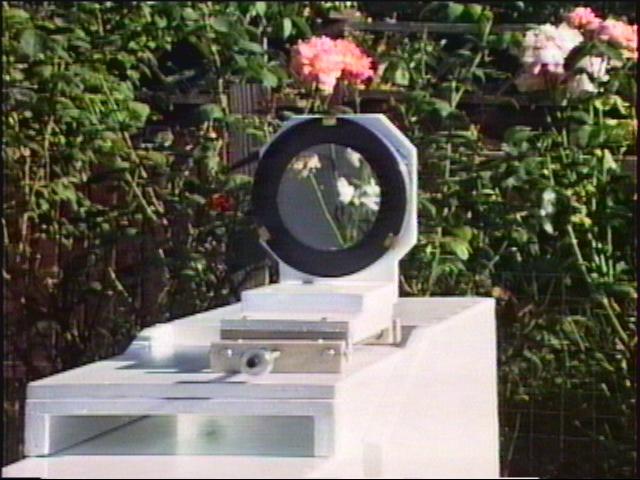
The telescope mirror needs to be stopped down due to the generation of heat.
The business end of the spectrohelioscope

The box on the left side contains the grating, slits, nodding mirrors,
90 degree diagonal mirror, and the eyepiece.
The heliostat

A 6 inch flat, first surface mirror, on a tracking system,
guides the sunlight onto the telescope mirror.
A camcorder view of the spectrum

An experiment that can be improved upon, but interesting.
Nice colors
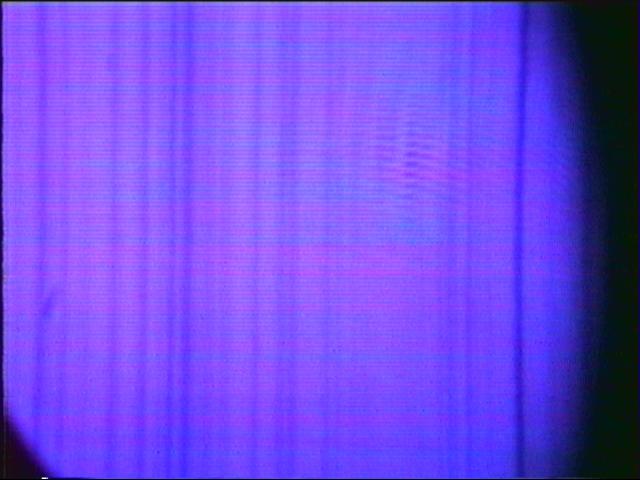
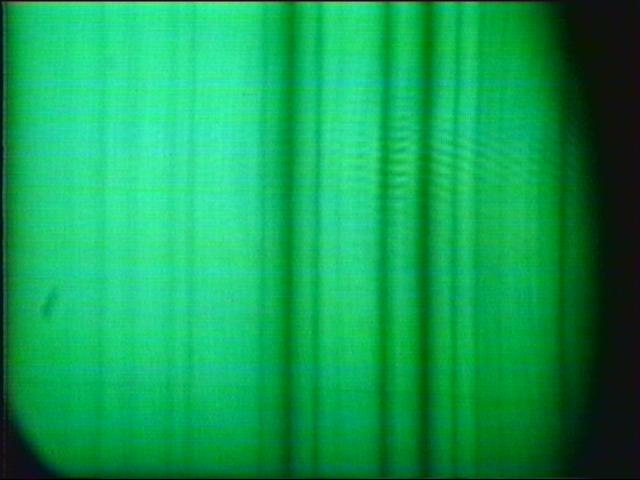
The detail of the spectrum can be improved by adjustment
of the entrance slit.
The exit slit is not used in the spectroscope mode.
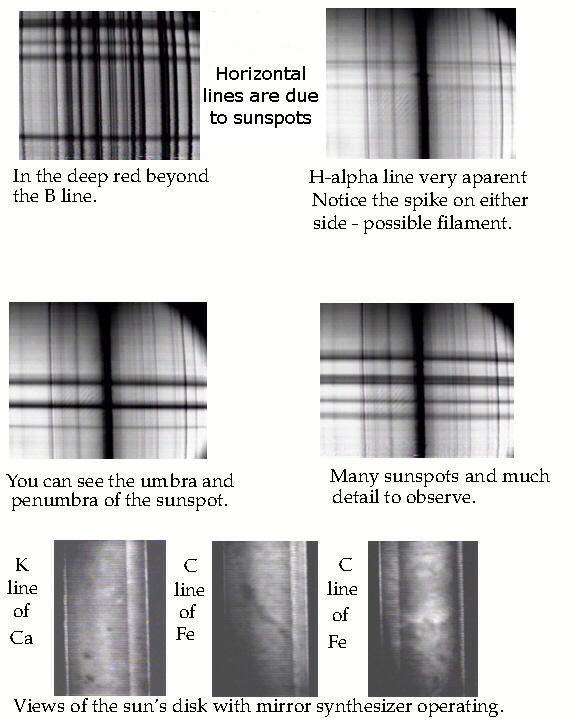
A Phillips FTM800 (Black and White) electronic camera was used for
the above images in the spectroscopic mode and the spectrohelioscope mode.
When observing the disk of the sun the sweep rate of the camera and the
nodder system produce vertical interference patterns. This can be
overcome with a system of synchronizing the camera and nodder. The
view of the sun's disk with one's eye is very good and the sun's disk reveals
much detail. The images above were taken on June 27,1999.

A sketch of the sun in H-alpha made on June 27, 1999 at 9:45AM P.D.S.T., 16:45 UT.
Not to scale, but an example of what can be seen. An interesting
experiment with this instrument is the ability to tune the H-alpha band.
One can observer the appearance of detail in different stages which indicate
the direction of velocity in the gases - notability the prominences.
Due to the optical train the image is reversed and backward. One
still observes the same detail, but oriented differently.
This web page was made possible by the Tri-Valley Stargazers with the assistance of Mike Rushford, "Eyes On the Skies"
a robotic solar telescope, located in Livermore, California.
Email: lhiggins@neteze.com
To acquire the book, "The Spectrohelioscope", send $25.00 to:
Fredrick Veio
P.O. Box 467
Clearlake Park, CA 95424
USA













